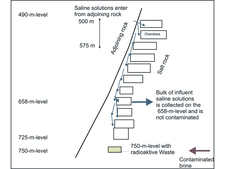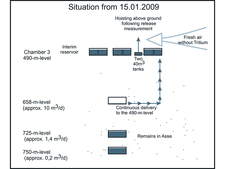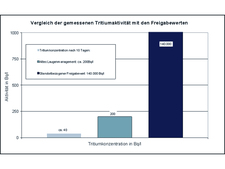-
Topics
subnavigation
Topics
What happens in the Asse?
Management of influent saline solutions
About 12,500 litres of saline solutions are collected daily in the Asse II mine. In order for the saline solution to be disposed or processed industrially, the locations where the solution is collected and the reservoirs on the 658-m level and the 490-m level are covered and provided with fresh air to keep the taking up of tritium through the mine air as low as possible.
Before they are given away, the saline solutions are cleared. Saline solutions collected below the 658-m level remain underground.
Point of inflow of saline solutions

![]() Point of inflow of saline solutions
Point of inflow of saline solutions
Saline solutions enter the salt dome from the adjoining rock in depths between 500 m and 575 m, from where they enter the mine. The major part of the influent saline solutions is collected on the 658-m level (ca. 11 cubic metres per day). Additional collecting points are on the 725-m level (ca. 0.8 cubic metres per day) and on the 750-m level (ca. 20 litres per day). Contaminated brines on the 750-m level are not to be confused with the influent saline solutions. They do not originate from the influent saline solutions but from the time the radioactive waste was emplaced.
Method applied since January 2009

![]() Taking up tritium from the mine air
Taking up tritium from the mine air
The former operator of Asse, Helmholtz Zentrum München (HMGU), did not immediately take the collected saline solutions to the area above ground but collected them in an interim reservoir initially. Thus, the influent saline solutions collected on the different levels were mixed. Until they were removed, the solutions remained underground for quite some time. During this period they had taken up the radioactive substance tritium from the mine air.
The BfS has examined how much tritium from the mine air is taken up per day by the influent saline solutions. Measurement results have shown that approximately 4 becquerel per litre is taken up per day by the solutions unless they are isolated from the mine air. The longer the saline solutions remain in the mine the higher is thus their radioactive exposure. If they are covered respectively taken above ground as soon as possible, the tritium concentration can be reduced.
After the change of operatorship, a new procedure for the management of influent saline solutions was introduced with the help of which the uptake of tritium from the mine air could be reduced clearly:

![]() Method applied since January 2009
Method applied since January 2009
- The saline solutions flowing in on the 658-m level are collected at covered collecting points and pumped into the covered interim reservoir on the 490-m level. They are strictly separated from all other liquids in the mine.
- The area on the 490-m level and on the 658-m level where the solutions are stored intermediately and covered is supplied with fresh air from above ground. Thus clearly less tritium gets into the influent saline solutions.
- The influent saline solutions are removed from the Asse II mine once a month.
The saline solutions collected on the 725-m and the 750-m level are not mixed with other solutions. They remain in the mine and are used internally for the production of Sorel concrete.

![]() Comparison of the measured tritium activity with the release values
Comparison of the measured tritium activity with the release values
Radiation protection
The BfS has set itself the goal not to exceed the value of 40 becquerel per litre. This is clearly below the tritium concentration whose maximum (100 becquerel per litre) is permissible according to the German Drinking Water Ordinance. With the brine (or saline solution) management of the former operator the values were generally in the range of circa 200 becquerel per litre.
The figure compares the valid release value with the reduced tritium exposure that can be achieved with the new management of the influent saline solutions.
State of 2017.02.27

